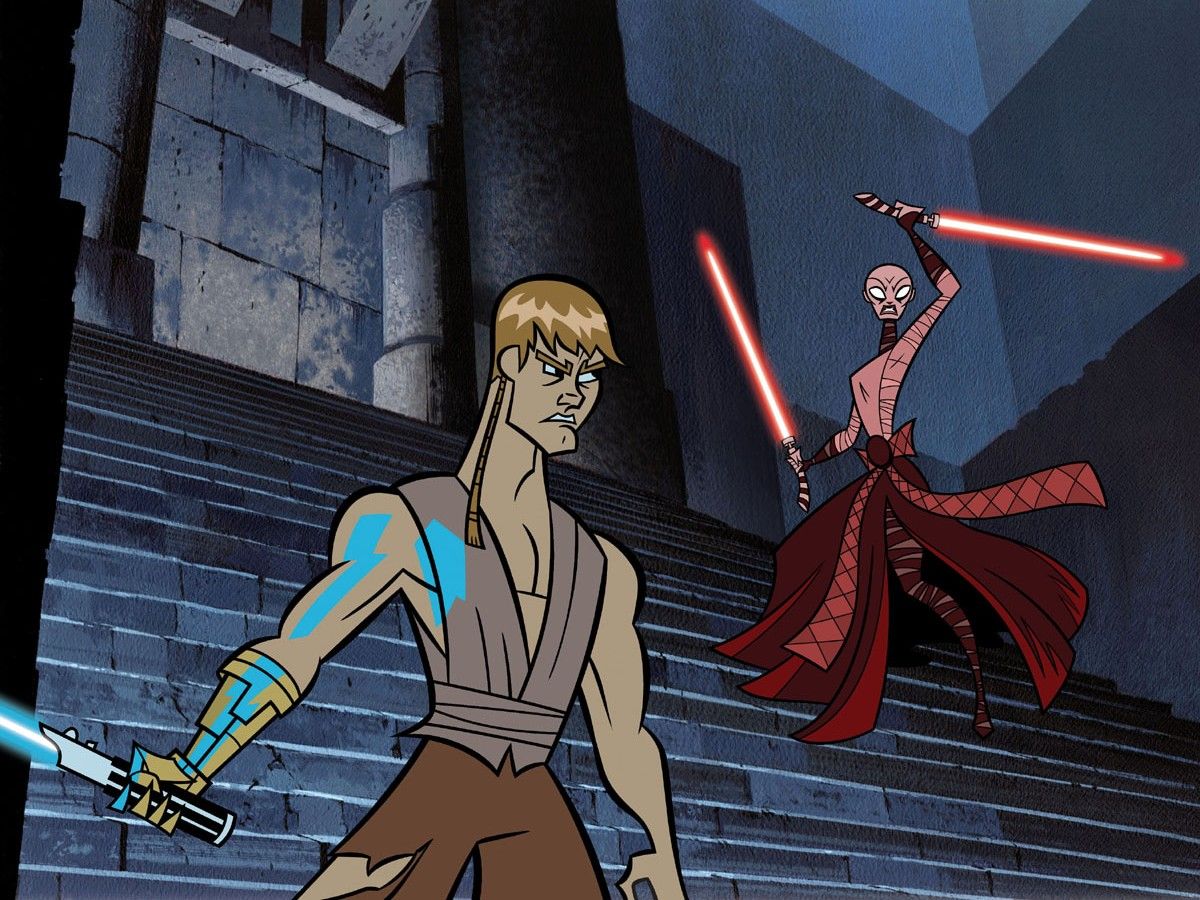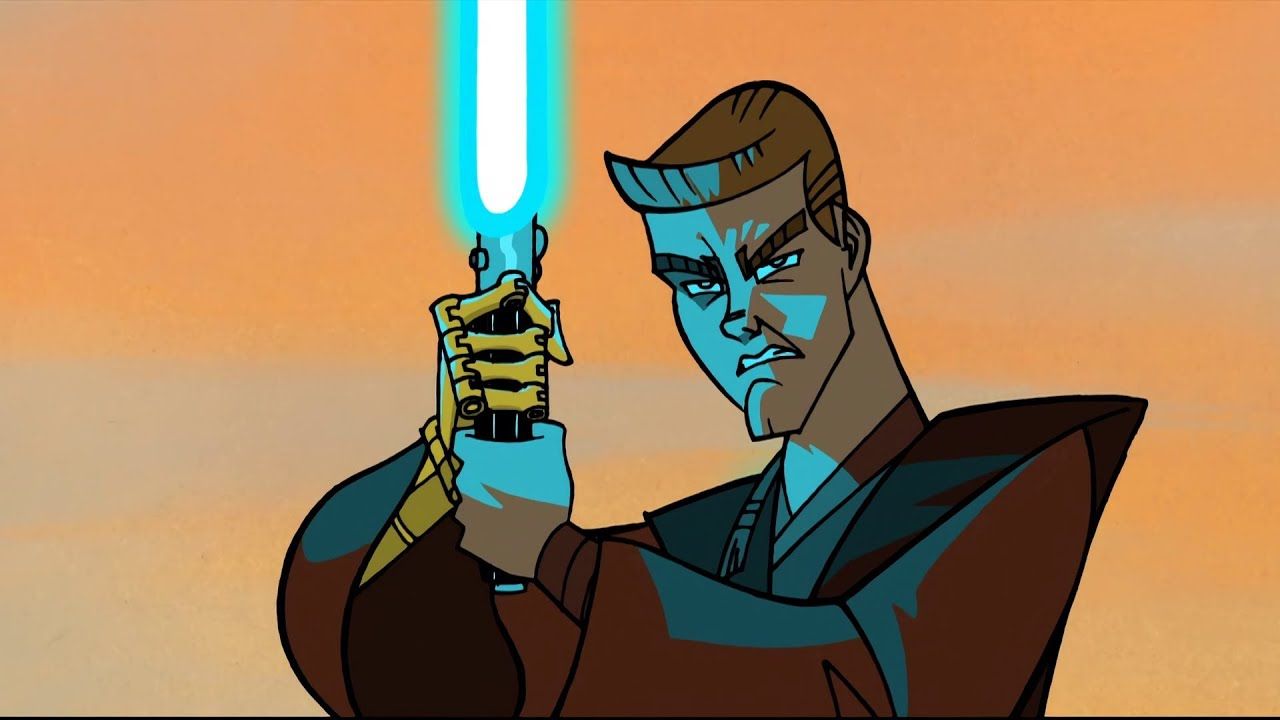Big Shiny Robot has agreed to let me do a column on Star Wars: The Clone Wars. I’m very excited to dive into The Clone Wars that we know and love, the animated series that the movie of the same title kicked off in 2008, but before I do, I want to devote time to the original Clone Wars animated series that started in 2003.
For the ease of my fingers and your eyes, I will be referring to the Clone Wars series by their dates for the remainder of this article.
2003 attempts to do what 2008 does: connect Attack of the Clones with Revenge of the Sith by showing us various events of the Clone Wars. Both series achieve this goal, but the seventh season of 2008 actively retcons 2003’s events leading up to Revenge of the Sith.
In the special features, the creators involved with 2003 describe Star Wars as a mythology of sorts, so in a way, it doesn’t really matter that one of these series is more canon than the other. It’s very easy to imagine the events happening in either universe.
2003 comprises two volumes. In the first, Anakin is still a padawan, while the second volume very quickly elevates him to the status of Jedi Knight. Due to the length of the episodes (only several minutes long), there is not a lot of room for an emphasis on character development or growth. Due to George Lucas advising in the special features that “it’s a war, a lot of action going on,” this seems deliberately intentional. If folks are fond of plot driven narratives, 2003 may be the version for you. For those who enjoy character centric work, the 2003 episodes are essentially a long action sequence, which may bore you.
There is not much added to Anakin’s and Obi-Wan’s relationship in Volume One. Anakin is reckless, and Obi-Wan continues to chide him for it. However, when Anakin is no longer Obi-Wan’s pupil, the relationship demonstrated in Revenge of the Sith becomes more apparent. That was of key importance during the creation of Volume Two, as also stated in the special features.
In Volume One, Anakin’s recklessness is primarily shown by Count Dooku setting Asajj Ventress after him. Asajj is one of the more well known antagonists in 2008, but is more often contextualized against Obi-Wan, as opposed to Anakin. In 2003, Asajj is all about Anakin as she believes killing him will allow her to become a Sith. Anakin’s conflict with Asajj is later revealed to be one of the trials towards becoming a Jedi Knight. Instead of becoming one of the most complicated antagonists to grace the small screens as Asajj does in 2008, Asajj is dead at the end of Volume One in 2003.

Still, 2003 packs a lot in their short episodes. Anakin’s inability to let go is clearly shown when Obi-Wan, knowing that Asajj is leading Anakin into a trap, orders him to let the enemy go. Of course, telling Anakin to let go of something is the same as asking for the impossible. This theme is threaded throughout all the Star Wars narratives to some degree or another, so it’s not surprising to see it here in 2003, especially as this was a pivotal character trait that contributed to Anakin’s fall to the Dark Side.
Volume Two shows Obi-Wan and Anakin on more equal footing as they were in Revenge of the Sith. Less chiding and more camaraderie. Perhaps the funniest moments where they are on equal ground is Anakin’s infamous bug eating scene before he leads Obi-Wan to the sewers in order to sneak behind enemy lines and secure a Republic victory. Obi-Wan’s, “What an incredible smell you’ve discovered” is a delightful nod to A New Hope as well.
Afterward, Anakin sets on a very spiritual mission that is very reminiscent of the Mortis arc in 2008. In the beginning of the volume, the Jedi Council ponders whether to promote Anakin to the position of Knighthood. Obi-Wan argues that he has already gone through many trials, though Yoda advises not the trial of the spirit. Towards the end of Volume Two, Anakin must do just that. He must look inwards towards himself, though Obi-Wan assures him he can still make his choices to shape his own destiny.
This is where 2003 falters the most. In order for Anakin to go on this spiritual journey, both he and Obi-Wan encounter a group of people who are strongly coded as indigenous, which is rather appropriative as it’s not about them, it’s about Anakin, and it’s unlikely any Native creators were consulted in creating the narrative.
To set Anakin off on his journey, he interrupts a rite of passage for a young man, who is supposed to find out what or who is terrorizing their village and defeat it. Since the rite of passage involves the killing of a beast, and Anakin kills the beast, he is sent in their stead.
He follows the instructions as provided by the village elder, and is led to a cave where there are paintings depicting people they’ve encountered. The painting becomes alive, showing a shadowy monster attacking them, and someone fighting it off, and losing a hand in the process (sound familiar?). However, the remaining shadow tendrils attach as a type of prosthetic hand that grows monstrous in turn. The man ends up attacking his village and the woman who loves him (again, sound familiar?). Finally, the monstrous hand grows and shifts, overcoming the man and the space around him, until it shapes into the well known visage of Darth Vader.
It evokes an unpleasant reminder of Obi-Wan telling Luke that Vader is “more machine now than man” and how that is linked to his villainy. It evokes ableist ideas that the status of one’s humanity is linked to the state of their body.
Even in the original trilogies, one of its great faults is that the primary villain is disabled. 2003 did nothing to rectify this misstep, and instead, made it worse. If you would like to read more about why the stereotype of the disabled villain is so negative, please click here.
Perhaps the reason this vision hurts more than Obi-Wan’s observation is because it literally shows the source of this person’s fall, who is so similar to Anakin, who is Anakin, in the prosthetic hand. The monster grows from the loss of the hand and the prosthetic.

It’s especially disappointing because Anakin was portrayed for nearly the entirety of Volume One without hiding his prosthetic hand. Luke was portrayed the same way at the end of Force Awakens. In these contexts, the hand is simply a prosthetic device instead of a metaphor for something more. Moments like Obi-Wan’s comments and the scene depicted in Volume Two undercut these statements. Overall, Star Wars has a long way to go when it comes to portraying disabled characters on screen.
After Anakin sees the vision, he discovers the missing villagers. They are being experimented on by the Separatists, being transformed into something monstrous, and many of them are missing hands of their own that have been replaced with weaponized prosthetics. (Why the Separatists are doing this is never fully explained.) Anakin ends up saving them, and they return home to be welcomed by their families after a moment of hesitancy.
I’m not sure if this trope fits exactly, but with the people of the village coded as Native, I don’t think I’m too far off the mark with labeling Anakin’s triumph and return as an example of the White Savior narrative, which is also a very imperialistic trope (ironic, since most of Star Wars is about fighting against an Empire).
Because of these unfortunate arcs, my favorite parts of 2003 don’t have much, if anything, to do with Anakin and Obi-Wan, but primarily with the other Jedi.
Volume One shows Barriss and Luminara working together in the caves of Ilum. There, Barriss learns her last lesson–the relationship of a kyber crystal with its saber with its Jedi. Luminara intones, “The crystal is the heart of the blade. The heart is the crystal of the Jedi. The Jedi is the crystal of the Force. The Force is the blade of the heart. All are intertwined. The crystal. The blade. The Jedi. You are one.” Isn’t that just a beautiful sentiment? Some of this is seen with 2008, though it’s shortened to a lightsaber being a Jedi’s life, but reminds me most strongly of the prayer in Rogue One: The Force is with me, and I am one with the Force.
I live for details like this when it comes to the Jedis’ relationship with the Force. This sacred moment with Barriss and Luminara also makes what we see of them in 2008 far more impactful.
Another small moment I adored is Mace Windu fighting off a large army of battle droids while a small child watches from a hill. At the end, Mace jumps to the hill, and looks at the child. The child’s face glows with awe and admiration, and then he offers Mace a drink of water. It is such a small gesture, a small kindness. From the moment I first watched 2003 some years ago, this moment between Mace and the child has stayed in my memory. Volume Two also showed us that Mace’s ship is pink, and I respect that.
One of the most striking things in 2003 is the animation. It’s gorgeous, but its triumph is the animation of General Grievous. Relying on negative space, the appearance of the General is unsettling, and puts pressure on Jedi that we do not really see in 2008 or Revenge of the Sith. 2003 embodies tangible fear from the Jedi for General Grievous, from Shaak Ti’s panic at realizing she has to fight him for a second time (when she barely escaped with her life the first time) to his sheer, unescapable presence as the animated series dovetails into Revenge of the Sith.
Other fun moments are when Jedi cast off their cloaks. Every time encompasses dramatic flair impossible to achieve in the live action and that 2008 unfortunately did not replicate.
When it rains, the lightsabers sizzle. Even in the 2003 version of the 2008 “Water War” arc, such care was given to animate the lightsaber differently under water.
The artists took the theme of knighthood wholeheartedly. In Volume One, Obi Wan is shown in full fledged clone armor, with only his cloak alerting us to the fact he’s a Jedi, not a clone trooper. Droids carry joust shaped weapons as both sides clash against each other. The blending of a future a long time ago in a galaxy far far away with imagery evoking knights of the middle ages is captivating.
So is 2003 worth watching? It depends on what you want out of Star Wars. For those who aren’t sure, I’ve shared my favorite moments in this article, but just because they are my favorite doesn’t mean they will be yours, or that I didn’t leave something out that would catch your imagination just as strongly.
I will say with every confidence that the Lego special “Revenge of the Brick” is perhaps the most painful five minutes you will endure from a Star Wars narrative. Best to skip.
As far as I’m aware, The Clone Wars 2003 is not currently available for streaming.